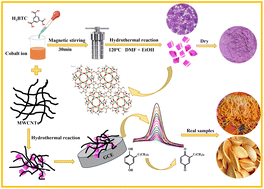Co-MOF@MWCNTs/GCE for the sensitive detection of TBHQ in food samples†
Abstract
tert-Butylhydroquinone (TBHQ) is a novel synthetic antioxidant with a higher safety profile and antioxidant effect that is more excellent than other synthetic antioxidants and is internationally recognized as one of the best food antioxidants. However, its excessive use in food can have unfavorable effects on the human body. Thus, it is critical to establish a rapid method for the detection of TBHQ in food samples. In this study, a cobalt-based metal–organic framework (Co-MOF) was fabricated by a one-pot hydrothermal method and embedded in multi-walled carbon nanotubes (MWCNTs) to construct an economical and sensitive electrochemical sensor for TBHQ. The results showed that this sensor possessed a wide linear range (0.004–20 μM and 20–300 μM), a low limit of detection (LOD = 2.5 nM, S/N = 3) as well as an ultra-high sensitivity (43.19 μA μM−1 cm−2). Moreover, the sensor also has superior selectivity, repeatability, reproducibility and anti-interference ability and can be successfully applied for the detection of TBHQ in samples of instant noodles and potato chips.



 Please wait while we load your content...
Please wait while we load your content...